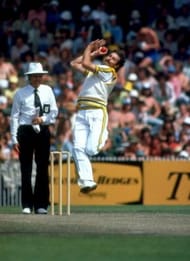Continuing with our series on the greatest cricketers of all time, here’s No. 18 on our list.
No. 18 – Dennis Lillee
When the average sportsman is diagnosed with multiple spinal fractures, you cannot help but expect there to be a huge question mark over his career. However, when we talk of Dennis Lillee, the word ‘average’ goes out of the window. Not only did Lillee overcome debilitating injuries through sheer willpower, but he also returned to the cricket field and made it his own, in the process taking his place among the pantheon of all-time greats. That’s the kind of iron-willed character we are talking about.
When Lillee started out as a hot-blooded young fast bowler for Australia in 1971, pace was the only language that Lillee spoke. Holding nothing back either in his run-up or delivery stride, he terrorized batsmen with the kind of brutality that only genuine fast bowlers are blessed with. I could try, but it’s not really possible to do justice to such riotous fast bowling through mere words.
But bowling long spells with such a wild action was bound to take its toll some day or the other. After experiencing frequent bouts of pain in his back, Lillee finally broke down in 1973 and was sidelined from Test cricket for nearly two years. It has always been widely believed that the kind of injury that Lillee suffered would spell doom for any fast bowler’s career. But Lillee did not subscribe to this theory and embarked on a rehabilitation program that should serve as an example for injured sportsmen for ages to come.
Working with his physiotherapist and following a harsh regimen, Lillee turned his bowling into a science. Each step was now carefully optimized to prevent any recurrence of the back injury. While he lost some of his pace through this process, he gained control and deadly accuracy. Emerging from the rehabilitation was Dennis Lillee 2.0: the new and improved version.
Many consider Rahul Dravid’s batting style to be something straight out of a cricket textbook. If such a copybook-perfect style were to be sought among bowlers, Lillee would undoubtedly be at the top. Post-injury, he developed an incredible economy of movement, and he seemed to glide to the crease rather than run towards it.
Lillee was extremely popular with the crowds; in Australia, his name was almost invariably chanted loudly by the spectators whenever he charged in to bowl. A part of this popularity was undeniably a result of his charismatic personality. A burly moustache, a long flowing mane of hair and the shirt worn with half the buttons unbuttoned created a persona that was to become the poster image for fast bowling throughout the 70’s and early 80’s.
Lillee partnered Jeff Thomson to form one of the deadliest fast bowling combos of all time, rivaled only by the fearsome West Indies pace attack of the 80′s. While Thomson softened the batsmen with his lethal bouncers, Lillee lapped up the wickets with his amazing variations. He was also involved in a fruitful partnership with wicket-keeper Rod Marsh, accumulating a total of 95 dismissals in tandem with him, a record that still stands.
Lillee’s fighting spirit also bred a certain amount of rebelliousness. It manifested itself most memorably in a humorous incidence at Perth when Lillee walked in with an aluminium bat, only to be rebuked by everyone on the field. It took a lot of convincing from the umpires for him to switch to a conventional wooden bat. Lillee was also one of the first cricketers to sign up for the rebel World Series Cricket league, which was instrumental in the commercialization of cricket.
By the time he was done with international cricket, Lillee had collected a total of 355 Test scalps – a very impressive tally considering that it took him only 70 Tests to accomplish it. Post-retirement, he devoted his time to nurturing young fast bowlers, and did a very impressive job of it which is evident from the fact that Brett Lee and Shaun Tait are among his pupils.
Dennis Lillee played in the golden era of fast bowling and there were many then who could stake a claim to the throne of the world’s best fast bowler. Yet, it was Lillee who came to be known, and is still known, as ‘the complete fast bowler’.
Here is a video of Lillee decimating a World XI side in his pre-injury days through his sheer unbridled pace.
Here are the other players who have made it so far:
No. 20 – Bill O’Reilly
No. 19 – Fred Trueman
Read the detailed write-ups on all the players in this list here:
The greatest cricketers of all time
Looking for fast live cricket scores? Download CricRocket and get fast score updates, top-notch commentary in-depth match stats & much more! 🚀☄️

